Supporting Independent Living: Technology, Barriers, and Benefits
VerifiedAdded on 2020/06/04
|12
|4094
|51
Report
AI Summary
This report delves into the use of technology to support independent living, focusing on assistive devices and their impact on service users. It begins with an introduction to the concept of independent living and the role of technology, followed by a discussion of recent technological advancements and their effects on both service providers and individuals. The report highlights various technologies, such as assistive devices, adapted keyboards, and modified vehicles, and their benefits in enabling individuals to perform daily activities and maintain a degree of independence. It also addresses potential barriers to technology adoption, including high costs, technical difficulties, and the need for proper training. Furthermore, the report examines health and safety considerations associated with the use of these technologies, such as equipment testing, maintenance, and potential risks. The report concludes with a recommendation on how technology can be used to support independent living and an evaluation of its usefulness, emphasizing the importance of comprehensive support and ongoing adaptation.

Supporting Independent living
Paraphrase This Document
Need a fresh take? Get an instant paraphrase of this document with our AI Paraphraser
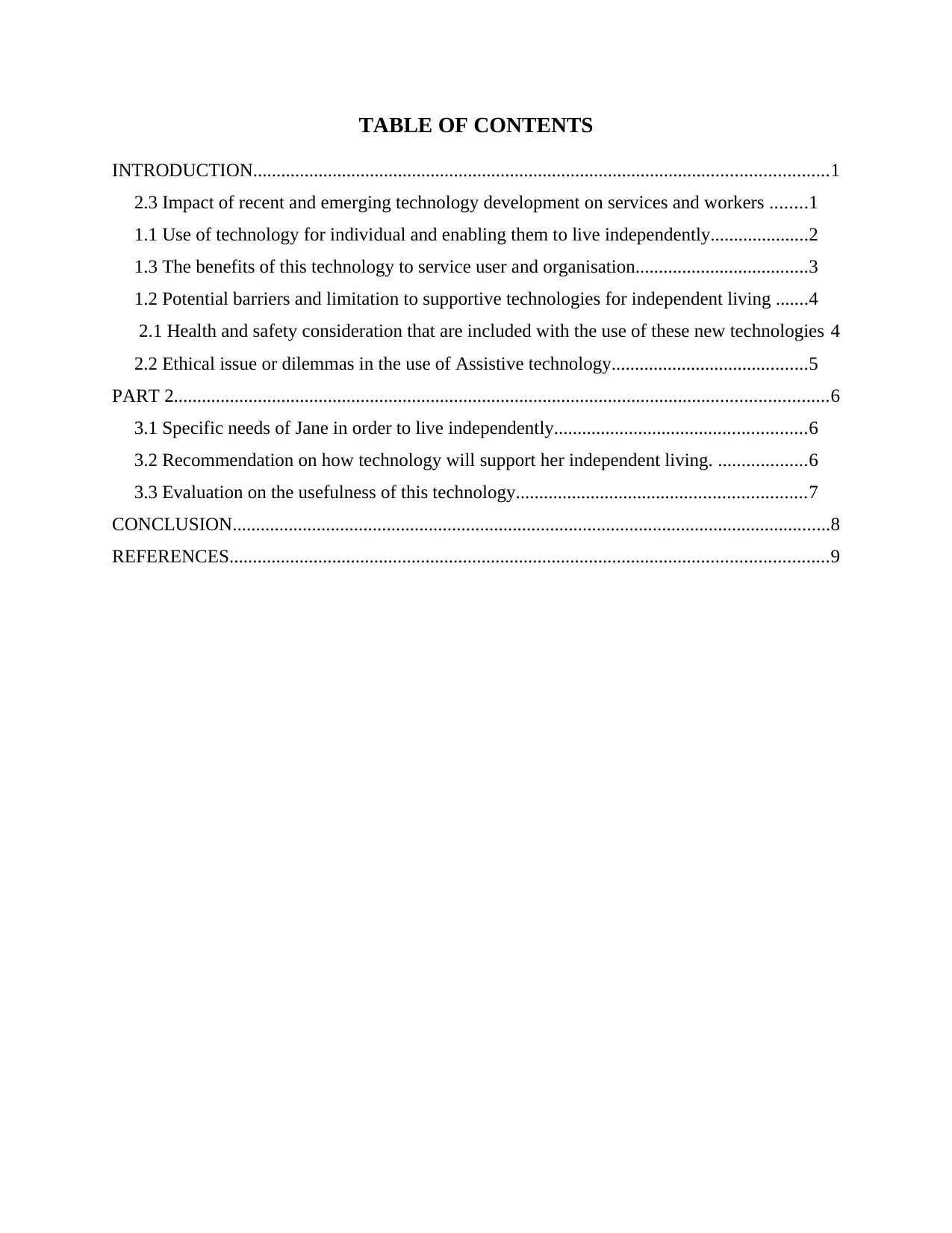
TABLE OF CONTENTS
INTRODUCTION...........................................................................................................................1
2.3 Impact of recent and emerging technology development on services and workers ........1
1.1 Use of technology for individual and enabling them to live independently.....................2
1.3 The benefits of this technology to service user and organisation.....................................3
1.2 Potential barriers and limitation to supportive technologies for independent living .......4
2.1 Health and safety consideration that are included with the use of these new technologies 4
2.2 Ethical issue or dilemmas in the use of Assistive technology..........................................5
PART 2............................................................................................................................................6
3.1 Specific needs of Jane in order to live independently......................................................6
3.2 Recommendation on how technology will support her independent living. ...................6
3.3 Evaluation on the usefulness of this technology..............................................................7
CONCLUSION................................................................................................................................8
REFERENCES................................................................................................................................9
INTRODUCTION...........................................................................................................................1
2.3 Impact of recent and emerging technology development on services and workers ........1
1.1 Use of technology for individual and enabling them to live independently.....................2
1.3 The benefits of this technology to service user and organisation.....................................3
1.2 Potential barriers and limitation to supportive technologies for independent living .......4
2.1 Health and safety consideration that are included with the use of these new technologies 4
2.2 Ethical issue or dilemmas in the use of Assistive technology..........................................5
PART 2............................................................................................................................................6
3.1 Specific needs of Jane in order to live independently......................................................6
3.2 Recommendation on how technology will support her independent living. ...................6
3.3 Evaluation on the usefulness of this technology..............................................................7
CONCLUSION................................................................................................................................8
REFERENCES................................................................................................................................9
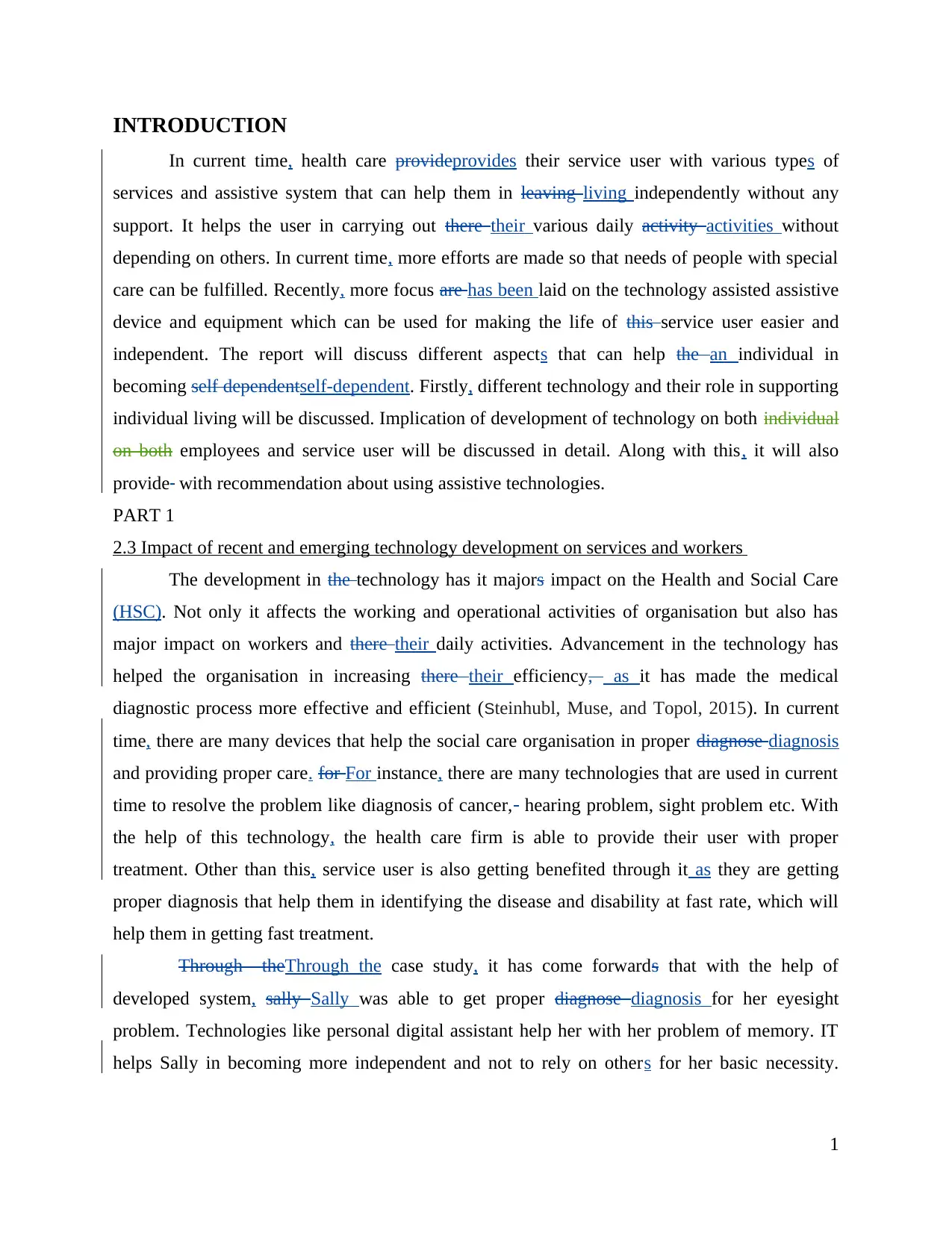
INTRODUCTION
In current time, health care provideprovides their service user with various types of
services and assistive system that can help them in leaving living independently without any
support. It helps the user in carrying out there their various daily activity activities without
depending on others. In current time, more efforts are made so that needs of people with special
care can be fulfilled. Recently, more focus are has been laid on the technology assisted assistive
device and equipment which can be used for making the life of this service user easier and
independent. The report will discuss different aspects that can help the an individual in
becoming self dependentself-dependent. Firstly, different technology and their role in supporting
individual living will be discussed. Implication of development of technology on both individual
on both employees and service user will be discussed in detail. Along with this, it will also
provide with recommendation about using assistive technologies.
PART 1
2.3 Impact of recent and emerging technology development on services and workers
The development in the technology has it majors impact on the Health and Social Care
(HSC). Not only it affects the working and operational activities of organisation but also has
major impact on workers and there their daily activities. Advancement in the technology has
helped the organisation in increasing there their efficiency, as it has made the medical
diagnostic process more effective and efficient (Steinhubl, Muse, and Topol, 2015). In current
time, there are many devices that help the social care organisation in proper diagnose diagnosis
and providing proper care. for For instance, there are many technologies that are used in current
time to resolve the problem like diagnosis of cancer, hearing problem, sight problem etc. With
the help of this technology, the health care firm is able to provide their user with proper
treatment. Other than this, service user is also getting benefited through it as they are getting
proper diagnosis that help them in identifying the disease and disability at fast rate, which will
help them in getting fast treatment.
Through theThrough the case study, it has come forwards that with the help of
developed system, sally Sally was able to get proper diagnose diagnosis for her eyesight
problem. Technologies like personal digital assistant help her with her problem of memory. IT
helps Sally in becoming more independent and not to rely on others for her basic necessity.
1
In current time, health care provideprovides their service user with various types of
services and assistive system that can help them in leaving living independently without any
support. It helps the user in carrying out there their various daily activity activities without
depending on others. In current time, more efforts are made so that needs of people with special
care can be fulfilled. Recently, more focus are has been laid on the technology assisted assistive
device and equipment which can be used for making the life of this service user easier and
independent. The report will discuss different aspects that can help the an individual in
becoming self dependentself-dependent. Firstly, different technology and their role in supporting
individual living will be discussed. Implication of development of technology on both individual
on both employees and service user will be discussed in detail. Along with this, it will also
provide with recommendation about using assistive technologies.
PART 1
2.3 Impact of recent and emerging technology development on services and workers
The development in the technology has it majors impact on the Health and Social Care
(HSC). Not only it affects the working and operational activities of organisation but also has
major impact on workers and there their daily activities. Advancement in the technology has
helped the organisation in increasing there their efficiency, as it has made the medical
diagnostic process more effective and efficient (Steinhubl, Muse, and Topol, 2015). In current
time, there are many devices that help the social care organisation in proper diagnose diagnosis
and providing proper care. for For instance, there are many technologies that are used in current
time to resolve the problem like diagnosis of cancer, hearing problem, sight problem etc. With
the help of this technology, the health care firm is able to provide their user with proper
treatment. Other than this, service user is also getting benefited through it as they are getting
proper diagnosis that help them in identifying the disease and disability at fast rate, which will
help them in getting fast treatment.
Through theThrough the case study, it has come forwards that with the help of
developed system, sally Sally was able to get proper diagnose diagnosis for her eyesight
problem. Technologies like personal digital assistant help her with her problem of memory. IT
helps Sally in becoming more independent and not to rely on others for her basic necessity.
1
⊘ This is a preview!⊘
Do you want full access?
Subscribe today to unlock all pages.

Trusted by 1+ million students worldwide
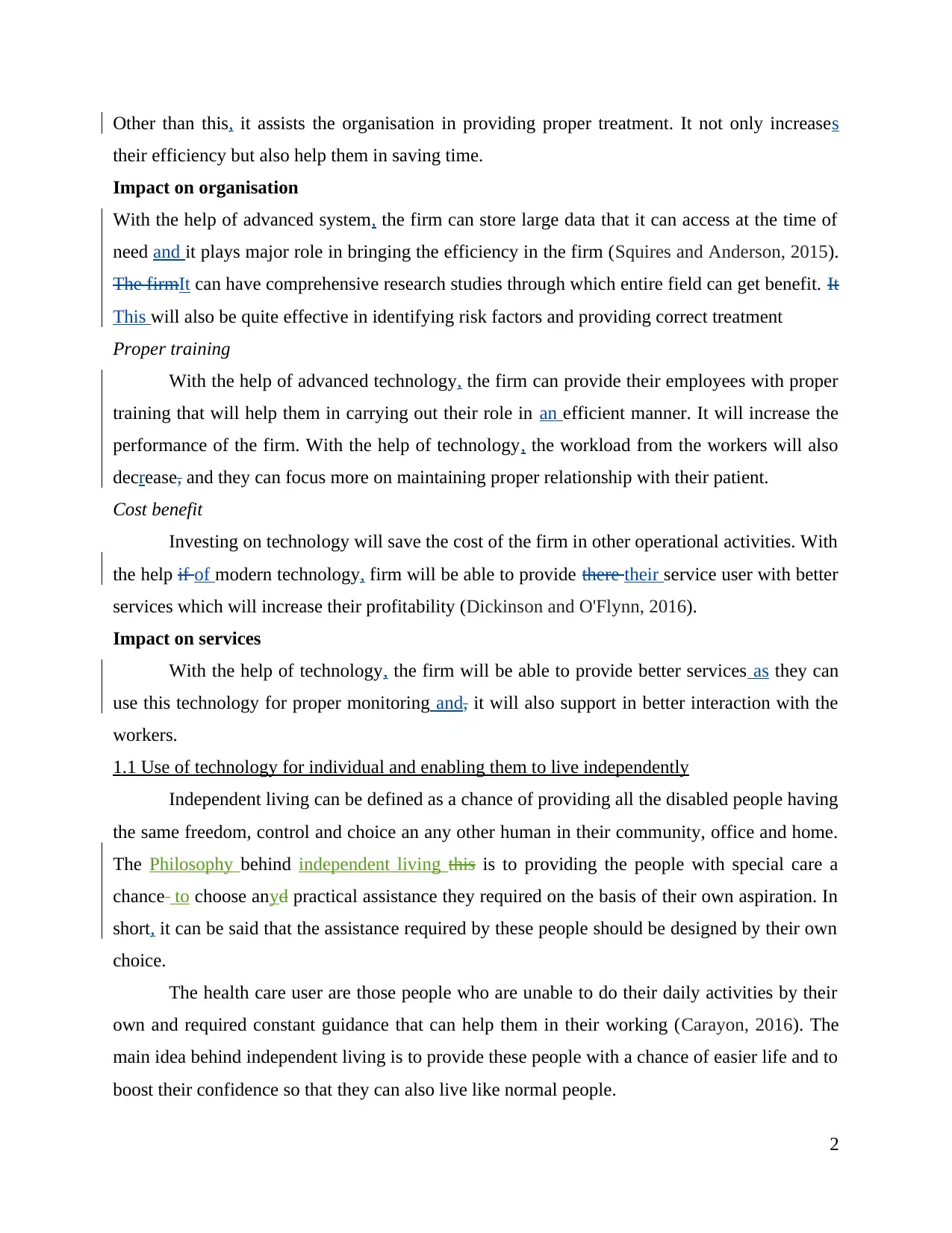
Other than this, it assists the organisation in providing proper treatment. It not only increases
their efficiency but also help them in saving time.
Impact on organisation
With the help of advanced system, the firm can store large data that it can access at the time of
need and it plays major role in bringing the efficiency in the firm (Squires and Anderson, 2015).
The firmIt can have comprehensive research studies through which entire field can get benefit. It
This will also be quite effective in identifying risk factors and providing correct treatment
Proper training
With the help of advanced technology, the firm can provide their employees with proper
training that will help them in carrying out their role in an efficient manner. It will increase the
performance of the firm. With the help of technology, the workload from the workers will also
decrease, and they can focus more on maintaining proper relationship with their patient.
Cost benefit
Investing on technology will save the cost of the firm in other operational activities. With
the help if of modern technology, firm will be able to provide there their service user with better
services which will increase their profitability (Dickinson and O'Flynn, 2016).
Impact on services
With the help of technology, the firm will be able to provide better services as they can
use this technology for proper monitoring and, it will also support in better interaction with the
workers.
1.1 Use of technology for individual and enabling them to live independently
Independent living can be defined as a chance of providing all the disabled people having
the same freedom, control and choice an any other human in their community, office and home.
The Philosophy behind independent living this is to providing the people with special care a
chance to choose anyd practical assistance they required on the basis of their own aspiration. In
short, it can be said that the assistance required by these people should be designed by their own
choice.
The health care user are those people who are unable to do their daily activities by their
own and required constant guidance that can help them in their working (Carayon, 2016). The
main idea behind independent living is to provide these people with a chance of easier life and to
boost their confidence so that they can also live like normal people.
2
their efficiency but also help them in saving time.
Impact on organisation
With the help of advanced system, the firm can store large data that it can access at the time of
need and it plays major role in bringing the efficiency in the firm (Squires and Anderson, 2015).
The firmIt can have comprehensive research studies through which entire field can get benefit. It
This will also be quite effective in identifying risk factors and providing correct treatment
Proper training
With the help of advanced technology, the firm can provide their employees with proper
training that will help them in carrying out their role in an efficient manner. It will increase the
performance of the firm. With the help of technology, the workload from the workers will also
decrease, and they can focus more on maintaining proper relationship with their patient.
Cost benefit
Investing on technology will save the cost of the firm in other operational activities. With
the help if of modern technology, firm will be able to provide there their service user with better
services which will increase their profitability (Dickinson and O'Flynn, 2016).
Impact on services
With the help of technology, the firm will be able to provide better services as they can
use this technology for proper monitoring and, it will also support in better interaction with the
workers.
1.1 Use of technology for individual and enabling them to live independently
Independent living can be defined as a chance of providing all the disabled people having
the same freedom, control and choice an any other human in their community, office and home.
The Philosophy behind independent living this is to providing the people with special care a
chance to choose anyd practical assistance they required on the basis of their own aspiration. In
short, it can be said that the assistance required by these people should be designed by their own
choice.
The health care user are those people who are unable to do their daily activities by their
own and required constant guidance that can help them in their working (Carayon, 2016). The
main idea behind independent living is to provide these people with a chance of easier life and to
boost their confidence so that they can also live like normal people.
2
Paraphrase This Document
Need a fresh take? Get an instant paraphrase of this document with our AI Paraphraser
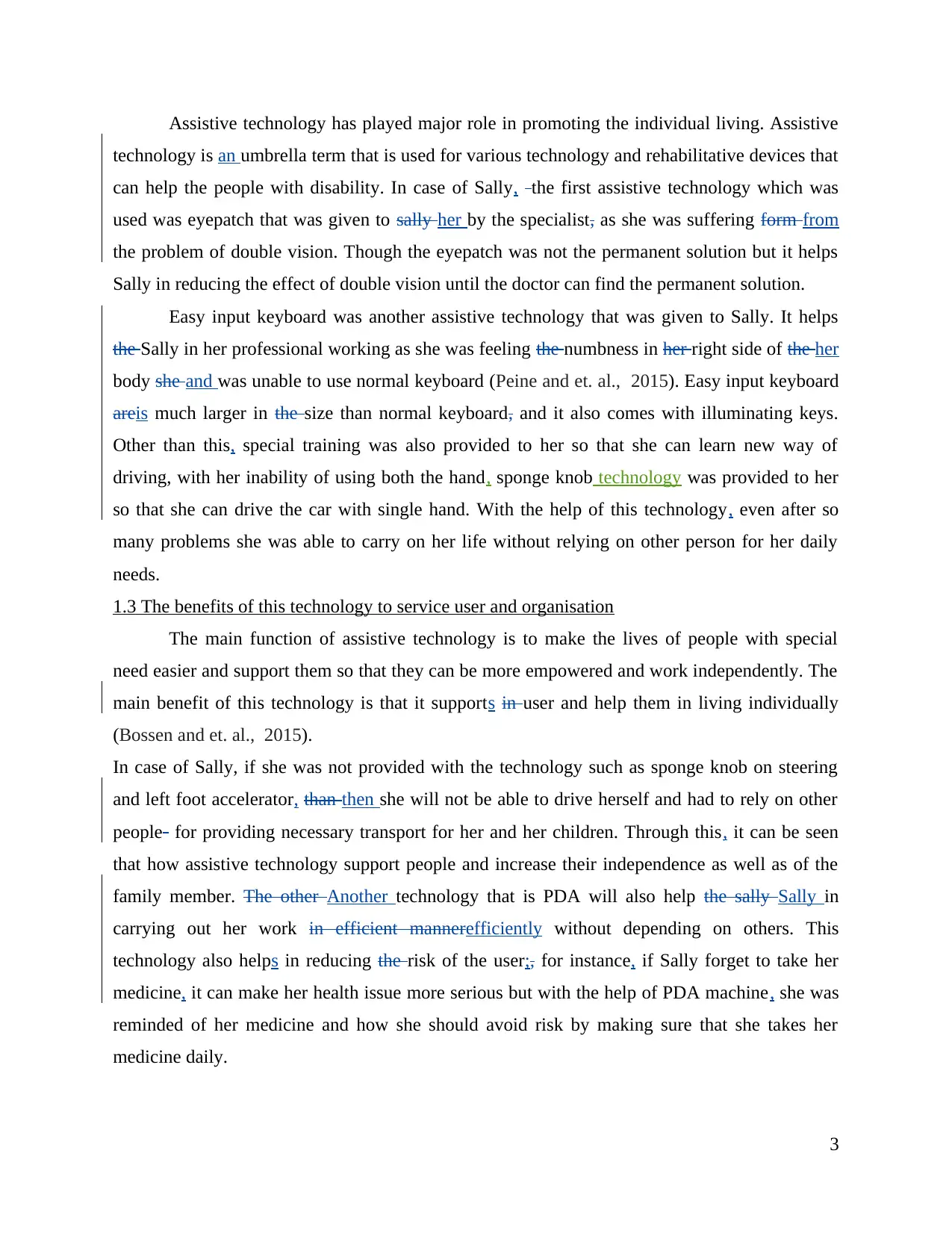
Assistive technology has played major role in promoting the individual living. Assistive
technology is an umbrella term that is used for various technology and rehabilitative devices that
can help the people with disability. In case of Sally, the first assistive technology which was
used was eyepatch that was given to sally her by the specialist, as she was suffering form from
the problem of double vision. Though the eyepatch was not the permanent solution but it helps
Sally in reducing the effect of double vision until the doctor can find the permanent solution.
Easy input keyboard was another assistive technology that was given to Sally. It helps
the Sally in her professional working as she was feeling the numbness in her right side of the her
body she and was unable to use normal keyboard (Peine and et. al., 2015). Easy input keyboard
areis much larger in the size than normal keyboard, and it also comes with illuminating keys.
Other than this, special training was also provided to her so that she can learn new way of
driving, with her inability of using both the hand, sponge knob technology was provided to her
so that she can drive the car with single hand. With the help of this technology, even after so
many problems she was able to carry on her life without relying on other person for her daily
needs.
1.3 The benefits of this technology to service user and organisation
The main function of assistive technology is to make the lives of people with special
need easier and support them so that they can be more empowered and work independently. The
main benefit of this technology is that it supports in user and help them in living individually
(Bossen and et. al., 2015).
In case of Sally, if she was not provided with the technology such as sponge knob on steering
and left foot accelerator, than then she will not be able to drive herself and had to rely on other
people for providing necessary transport for her and her children. Through this, it can be seen
that how assistive technology support people and increase their independence as well as of the
family member. The other Another technology that is PDA will also help the sally Sally in
carrying out her work in efficient mannerefficiently without depending on others. This
technology also helps in reducing the risk of the user;, for instance, if Sally forget to take her
medicine, it can make her health issue more serious but with the help of PDA machine, she was
reminded of her medicine and how she should avoid risk by making sure that she takes her
medicine daily.
3
technology is an umbrella term that is used for various technology and rehabilitative devices that
can help the people with disability. In case of Sally, the first assistive technology which was
used was eyepatch that was given to sally her by the specialist, as she was suffering form from
the problem of double vision. Though the eyepatch was not the permanent solution but it helps
Sally in reducing the effect of double vision until the doctor can find the permanent solution.
Easy input keyboard was another assistive technology that was given to Sally. It helps
the Sally in her professional working as she was feeling the numbness in her right side of the her
body she and was unable to use normal keyboard (Peine and et. al., 2015). Easy input keyboard
areis much larger in the size than normal keyboard, and it also comes with illuminating keys.
Other than this, special training was also provided to her so that she can learn new way of
driving, with her inability of using both the hand, sponge knob technology was provided to her
so that she can drive the car with single hand. With the help of this technology, even after so
many problems she was able to carry on her life without relying on other person for her daily
needs.
1.3 The benefits of this technology to service user and organisation
The main function of assistive technology is to make the lives of people with special
need easier and support them so that they can be more empowered and work independently. The
main benefit of this technology is that it supports in user and help them in living individually
(Bossen and et. al., 2015).
In case of Sally, if she was not provided with the technology such as sponge knob on steering
and left foot accelerator, than then she will not be able to drive herself and had to rely on other
people for providing necessary transport for her and her children. Through this, it can be seen
that how assistive technology support people and increase their independence as well as of the
family member. The other Another technology that is PDA will also help the sally Sally in
carrying out her work in efficient mannerefficiently without depending on others. This
technology also helps in reducing the risk of the user;, for instance, if Sally forget to take her
medicine, it can make her health issue more serious but with the help of PDA machine, she was
reminded of her medicine and how she should avoid risk by making sure that she takes her
medicine daily.
3
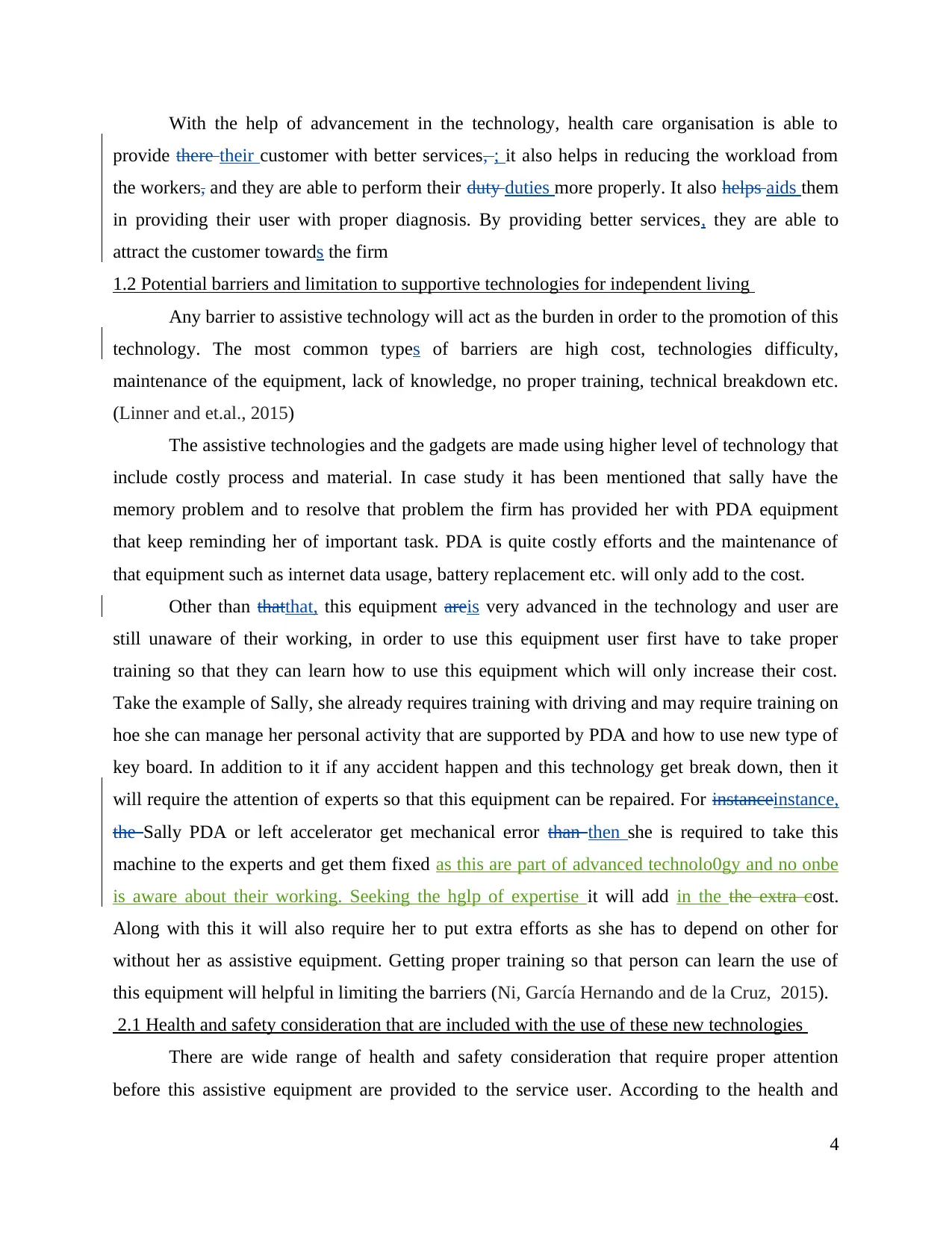
With the help of advancement in the technology, health care organisation is able to
provide there their customer with better services, ; it also helps in reducing the workload from
the workers, and they are able to perform their duty duties more properly. It also helps aids them
in providing their user with proper diagnosis. By providing better services, they are able to
attract the customer towards the firm
1.2 Potential barriers and limitation to supportive technologies for independent living
Any barrier to assistive technology will act as the burden in order to the promotion of this
technology. The most common types of barriers are high cost, technologies difficulty,
maintenance of the equipment, lack of knowledge, no proper training, technical breakdown etc.
(Linner and et.al., 2015)
The assistive technologies and the gadgets are made using higher level of technology that
include costly process and material. In case study it has been mentioned that sally have the
memory problem and to resolve that problem the firm has provided her with PDA equipment
that keep reminding her of important task. PDA is quite costly efforts and the maintenance of
that equipment such as internet data usage, battery replacement etc. will only add to the cost.
Other than thatthat, this equipment areis very advanced in the technology and user are
still unaware of their working, in order to use this equipment user first have to take proper
training so that they can learn how to use this equipment which will only increase their cost.
Take the example of Sally, she already requires training with driving and may require training on
hoe she can manage her personal activity that are supported by PDA and how to use new type of
key board. In addition to it if any accident happen and this technology get break down, then it
will require the attention of experts so that this equipment can be repaired. For instanceinstance,
the Sally PDA or left accelerator get mechanical error than then she is required to take this
machine to the experts and get them fixed as this are part of advanced technolo0gy and no onbe
is aware about their working. Seeking the hglp of expertise it will add in the the extra cost.
Along with this it will also require her to put extra efforts as she has to depend on other for
without her as assistive equipment. Getting proper training so that person can learn the use of
this equipment will helpful in limiting the barriers (Ni, García Hernando and de la Cruz, 2015).
2.1 Health and safety consideration that are included with the use of these new technologies
There are wide range of health and safety consideration that require proper attention
before this assistive equipment are provided to the service user. According to the health and
4
provide there their customer with better services, ; it also helps in reducing the workload from
the workers, and they are able to perform their duty duties more properly. It also helps aids them
in providing their user with proper diagnosis. By providing better services, they are able to
attract the customer towards the firm
1.2 Potential barriers and limitation to supportive technologies for independent living
Any barrier to assistive technology will act as the burden in order to the promotion of this
technology. The most common types of barriers are high cost, technologies difficulty,
maintenance of the equipment, lack of knowledge, no proper training, technical breakdown etc.
(Linner and et.al., 2015)
The assistive technologies and the gadgets are made using higher level of technology that
include costly process and material. In case study it has been mentioned that sally have the
memory problem and to resolve that problem the firm has provided her with PDA equipment
that keep reminding her of important task. PDA is quite costly efforts and the maintenance of
that equipment such as internet data usage, battery replacement etc. will only add to the cost.
Other than thatthat, this equipment areis very advanced in the technology and user are
still unaware of their working, in order to use this equipment user first have to take proper
training so that they can learn how to use this equipment which will only increase their cost.
Take the example of Sally, she already requires training with driving and may require training on
hoe she can manage her personal activity that are supported by PDA and how to use new type of
key board. In addition to it if any accident happen and this technology get break down, then it
will require the attention of experts so that this equipment can be repaired. For instanceinstance,
the Sally PDA or left accelerator get mechanical error than then she is required to take this
machine to the experts and get them fixed as this are part of advanced technolo0gy and no onbe
is aware about their working. Seeking the hglp of expertise it will add in the the extra cost.
Along with this it will also require her to put extra efforts as she has to depend on other for
without her as assistive equipment. Getting proper training so that person can learn the use of
this equipment will helpful in limiting the barriers (Ni, García Hernando and de la Cruz, 2015).
2.1 Health and safety consideration that are included with the use of these new technologies
There are wide range of health and safety consideration that require proper attention
before this assistive equipment are provided to the service user. According to the health and
4
⊘ This is a preview!⊘
Do you want full access?
Subscribe today to unlock all pages.

Trusted by 1+ million students worldwide
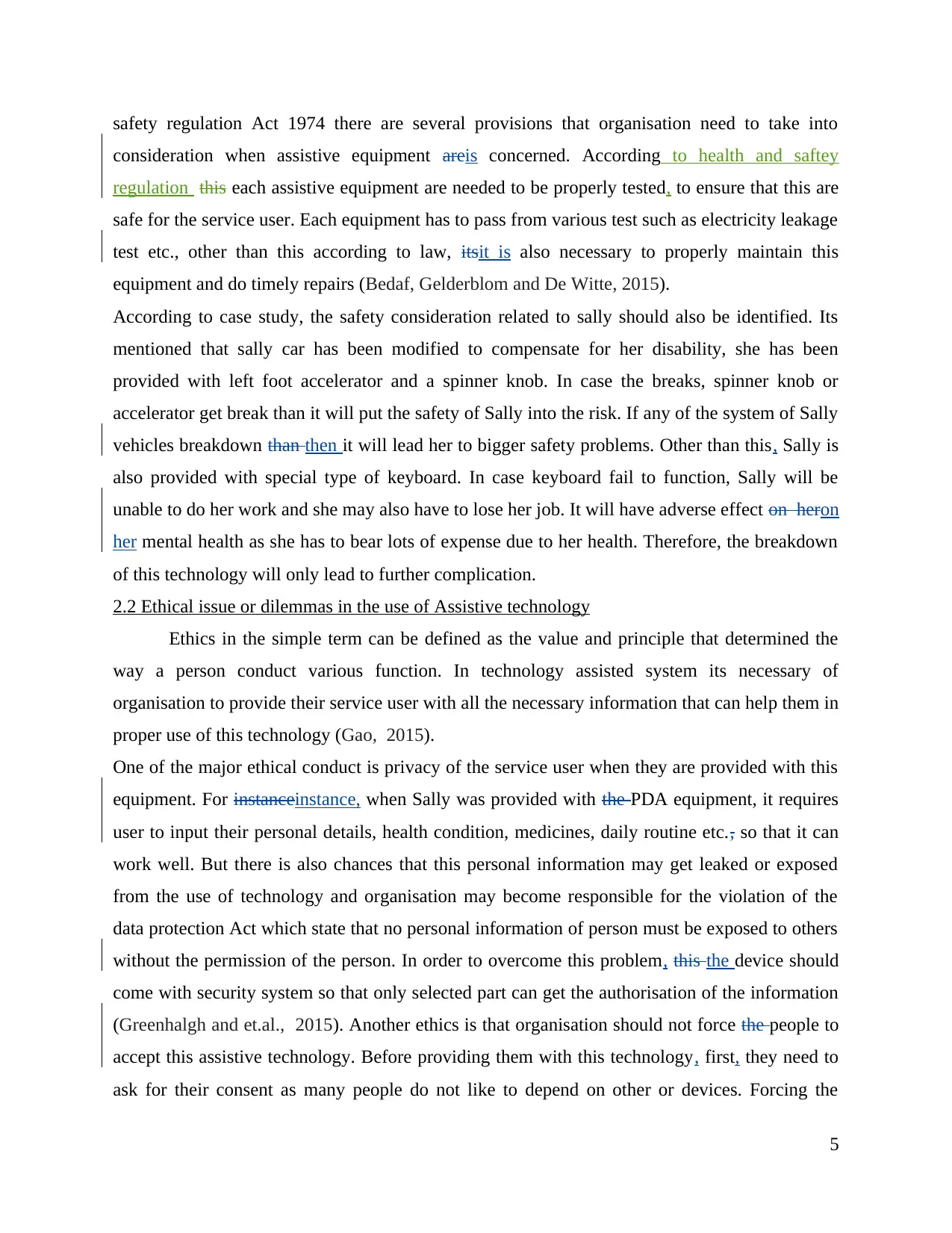
safety regulation Act 1974 there are several provisions that organisation need to take into
consideration when assistive equipment areis concerned. According to health and saftey
regulation this each assistive equipment are needed to be properly tested, to ensure that this are
safe for the service user. Each equipment has to pass from various test such as electricity leakage
test etc., other than this according to law, itsit is also necessary to properly maintain this
equipment and do timely repairs (Bedaf, Gelderblom and De Witte, 2015).
According to case study, the safety consideration related to sally should also be identified. Its
mentioned that sally car has been modified to compensate for her disability, she has been
provided with left foot accelerator and a spinner knob. In case the breaks, spinner knob or
accelerator get break than it will put the safety of Sally into the risk. If any of the system of Sally
vehicles breakdown than then it will lead her to bigger safety problems. Other than this, Sally is
also provided with special type of keyboard. In case keyboard fail to function, Sally will be
unable to do her work and she may also have to lose her job. It will have adverse effect on heron
her mental health as she has to bear lots of expense due to her health. Therefore, the breakdown
of this technology will only lead to further complication.
2.2 Ethical issue or dilemmas in the use of Assistive technology
Ethics in the simple term can be defined as the value and principle that determined the
way a person conduct various function. In technology assisted system its necessary of
organisation to provide their service user with all the necessary information that can help them in
proper use of this technology (Gao, 2015).
One of the major ethical conduct is privacy of the service user when they are provided with this
equipment. For instanceinstance, when Sally was provided with the PDA equipment, it requires
user to input their personal details, health condition, medicines, daily routine etc., so that it can
work well. But there is also chances that this personal information may get leaked or exposed
from the use of technology and organisation may become responsible for the violation of the
data protection Act which state that no personal information of person must be exposed to others
without the permission of the person. In order to overcome this problem, this the device should
come with security system so that only selected part can get the authorisation of the information
(Greenhalgh and et.al., 2015). Another ethics is that organisation should not force the people to
accept this assistive technology. Before providing them with this technology, first, they need to
ask for their consent as many people do not like to depend on other or devices. Forcing the
5
consideration when assistive equipment areis concerned. According to health and saftey
regulation this each assistive equipment are needed to be properly tested, to ensure that this are
safe for the service user. Each equipment has to pass from various test such as electricity leakage
test etc., other than this according to law, itsit is also necessary to properly maintain this
equipment and do timely repairs (Bedaf, Gelderblom and De Witte, 2015).
According to case study, the safety consideration related to sally should also be identified. Its
mentioned that sally car has been modified to compensate for her disability, she has been
provided with left foot accelerator and a spinner knob. In case the breaks, spinner knob or
accelerator get break than it will put the safety of Sally into the risk. If any of the system of Sally
vehicles breakdown than then it will lead her to bigger safety problems. Other than this, Sally is
also provided with special type of keyboard. In case keyboard fail to function, Sally will be
unable to do her work and she may also have to lose her job. It will have adverse effect on heron
her mental health as she has to bear lots of expense due to her health. Therefore, the breakdown
of this technology will only lead to further complication.
2.2 Ethical issue or dilemmas in the use of Assistive technology
Ethics in the simple term can be defined as the value and principle that determined the
way a person conduct various function. In technology assisted system its necessary of
organisation to provide their service user with all the necessary information that can help them in
proper use of this technology (Gao, 2015).
One of the major ethical conduct is privacy of the service user when they are provided with this
equipment. For instanceinstance, when Sally was provided with the PDA equipment, it requires
user to input their personal details, health condition, medicines, daily routine etc., so that it can
work well. But there is also chances that this personal information may get leaked or exposed
from the use of technology and organisation may become responsible for the violation of the
data protection Act which state that no personal information of person must be exposed to others
without the permission of the person. In order to overcome this problem, this the device should
come with security system so that only selected part can get the authorisation of the information
(Greenhalgh and et.al., 2015). Another ethics is that organisation should not force the people to
accept this assistive technology. Before providing them with this technology, first, they need to
ask for their consent as many people do not like to depend on other or devices. Forcing the
5
Paraphrase This Document
Need a fresh take? Get an instant paraphrase of this document with our AI Paraphraser
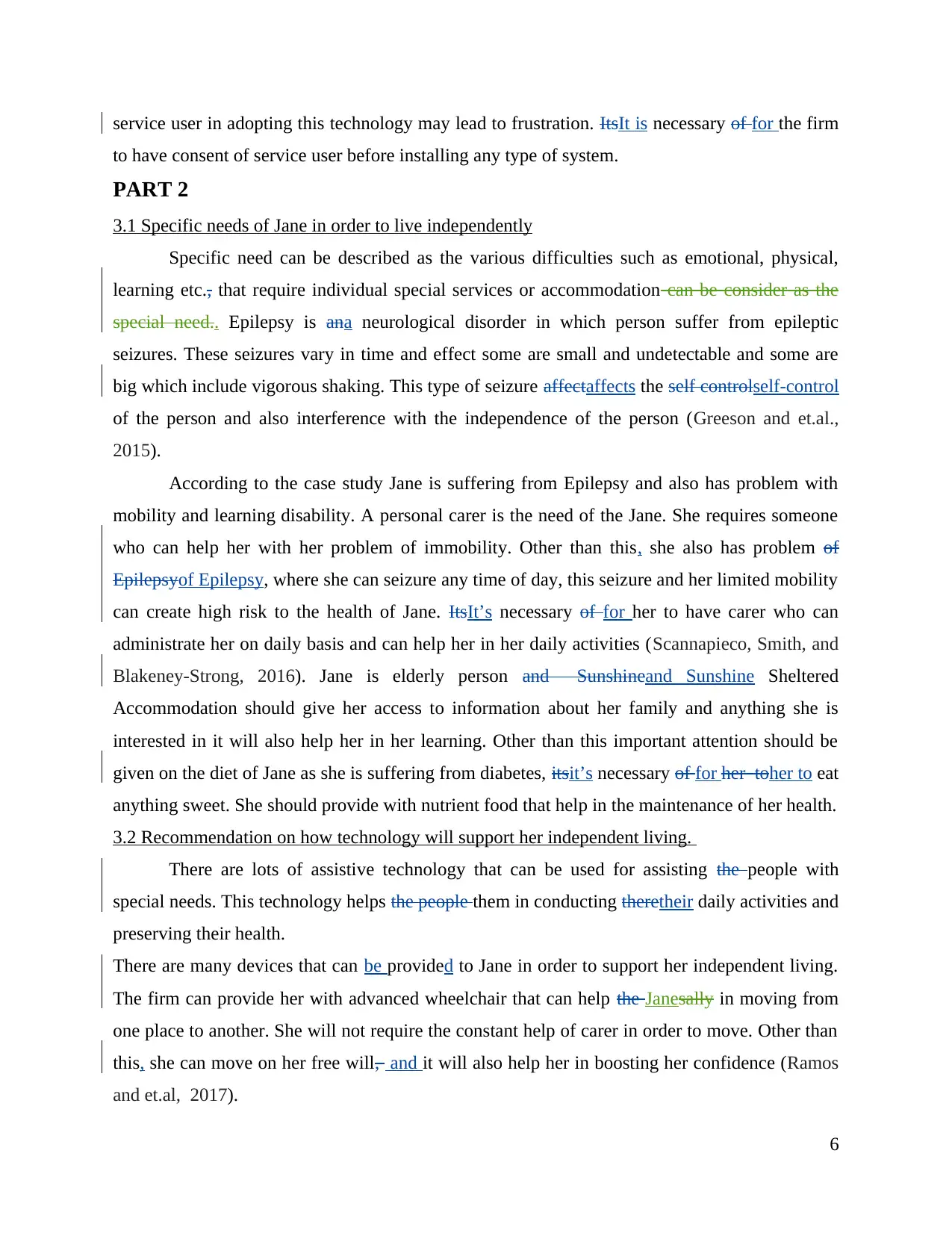
service user in adopting this technology may lead to frustration. ItsIt is necessary of for the firm
to have consent of service user before installing any type of system.
PART 2
3.1 Specific needs of Jane in order to live independently
Specific need can be described as the various difficulties such as emotional, physical,
learning etc., that require individual special services or accommodation can be consider as the
special need.. Epilepsy is ana neurological disorder in which person suffer from epileptic
seizures. These seizures vary in time and effect some are small and undetectable and some are
big which include vigorous shaking. This type of seizure affectaffects the self controlself-control
of the person and also interference with the independence of the person (Greeson and et.al.,
2015).
According to the case study Jane is suffering from Epilepsy and also has problem with
mobility and learning disability. A personal carer is the need of the Jane. She requires someone
who can help her with her problem of immobility. Other than this, she also has problem of
Epilepsyof Epilepsy, where she can seizure any time of day, this seizure and her limited mobility
can create high risk to the health of Jane. ItsIt’s necessary of for her to have carer who can
administrate her on daily basis and can help her in her daily activities (Scannapieco, Smith, and
Blakeney-Strong, 2016). Jane is elderly person and Sunshineand Sunshine Sheltered
Accommodation should give her access to information about her family and anything she is
interested in it will also help her in her learning. Other than this important attention should be
given on the diet of Jane as she is suffering from diabetes, itsit’s necessary of for her toher to eat
anything sweet. She should provide with nutrient food that help in the maintenance of her health.
3.2 Recommendation on how technology will support her independent living.
There are lots of assistive technology that can be used for assisting the people with
special needs. This technology helps the people them in conducting theretheir daily activities and
preserving their health.
There are many devices that can be provided to Jane in order to support her independent living.
The firm can provide her with advanced wheelchair that can help the Janesally in moving from
one place to another. She will not require the constant help of carer in order to move. Other than
this, she can move on her free will, and it will also help her in boosting her confidence (Ramos
and et.al, 2017).
6
to have consent of service user before installing any type of system.
PART 2
3.1 Specific needs of Jane in order to live independently
Specific need can be described as the various difficulties such as emotional, physical,
learning etc., that require individual special services or accommodation can be consider as the
special need.. Epilepsy is ana neurological disorder in which person suffer from epileptic
seizures. These seizures vary in time and effect some are small and undetectable and some are
big which include vigorous shaking. This type of seizure affectaffects the self controlself-control
of the person and also interference with the independence of the person (Greeson and et.al.,
2015).
According to the case study Jane is suffering from Epilepsy and also has problem with
mobility and learning disability. A personal carer is the need of the Jane. She requires someone
who can help her with her problem of immobility. Other than this, she also has problem of
Epilepsyof Epilepsy, where she can seizure any time of day, this seizure and her limited mobility
can create high risk to the health of Jane. ItsIt’s necessary of for her to have carer who can
administrate her on daily basis and can help her in her daily activities (Scannapieco, Smith, and
Blakeney-Strong, 2016). Jane is elderly person and Sunshineand Sunshine Sheltered
Accommodation should give her access to information about her family and anything she is
interested in it will also help her in her learning. Other than this important attention should be
given on the diet of Jane as she is suffering from diabetes, itsit’s necessary of for her toher to eat
anything sweet. She should provide with nutrient food that help in the maintenance of her health.
3.2 Recommendation on how technology will support her independent living.
There are lots of assistive technology that can be used for assisting the people with
special needs. This technology helps the people them in conducting theretheir daily activities and
preserving their health.
There are many devices that can be provided to Jane in order to support her independent living.
The firm can provide her with advanced wheelchair that can help the Janesally in moving from
one place to another. She will not require the constant help of carer in order to move. Other than
this, she can move on her free will, and it will also help her in boosting her confidence (Ramos
and et.al, 2017).
6
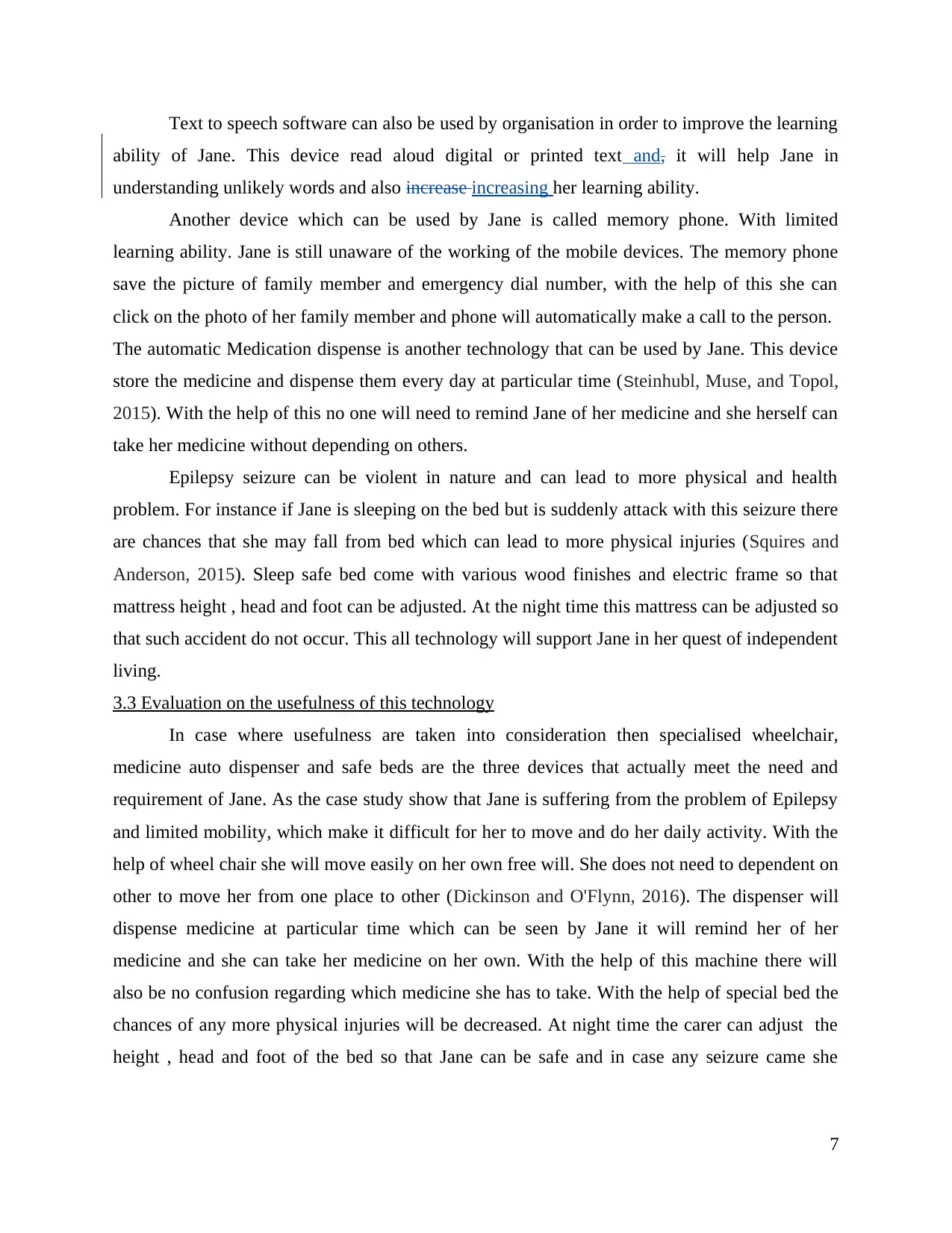
Text to speech software can also be used by organisation in order to improve the learning
ability of Jane. This device read aloud digital or printed text and, it will help Jane in
understanding unlikely words and also increase increasing her learning ability.
Another device which can be used by Jane is called memory phone. With limited
learning ability. Jane is still unaware of the working of the mobile devices. The memory phone
save the picture of family member and emergency dial number, with the help of this she can
click on the photo of her family member and phone will automatically make a call to the person.
The automatic Medication dispense is another technology that can be used by Jane. This device
store the medicine and dispense them every day at particular time (Steinhubl, Muse, and Topol,
2015). With the help of this no one will need to remind Jane of her medicine and she herself can
take her medicine without depending on others.
Epilepsy seizure can be violent in nature and can lead to more physical and health
problem. For instance if Jane is sleeping on the bed but is suddenly attack with this seizure there
are chances that she may fall from bed which can lead to more physical injuries (Squires and
Anderson, 2015). Sleep safe bed come with various wood finishes and electric frame so that
mattress height , head and foot can be adjusted. At the night time this mattress can be adjusted so
that such accident do not occur. This all technology will support Jane in her quest of independent
living.
3.3 Evaluation on the usefulness of this technology
In case where usefulness are taken into consideration then specialised wheelchair,
medicine auto dispenser and safe beds are the three devices that actually meet the need and
requirement of Jane. As the case study show that Jane is suffering from the problem of Epilepsy
and limited mobility, which make it difficult for her to move and do her daily activity. With the
help of wheel chair she will move easily on her own free will. She does not need to dependent on
other to move her from one place to other (Dickinson and O'Flynn, 2016). The dispenser will
dispense medicine at particular time which can be seen by Jane it will remind her of her
medicine and she can take her medicine on her own. With the help of this machine there will
also be no confusion regarding which medicine she has to take. With the help of special bed the
chances of any more physical injuries will be decreased. At night time the carer can adjust the
height , head and foot of the bed so that Jane can be safe and in case any seizure came she
7
ability of Jane. This device read aloud digital or printed text and, it will help Jane in
understanding unlikely words and also increase increasing her learning ability.
Another device which can be used by Jane is called memory phone. With limited
learning ability. Jane is still unaware of the working of the mobile devices. The memory phone
save the picture of family member and emergency dial number, with the help of this she can
click on the photo of her family member and phone will automatically make a call to the person.
The automatic Medication dispense is another technology that can be used by Jane. This device
store the medicine and dispense them every day at particular time (Steinhubl, Muse, and Topol,
2015). With the help of this no one will need to remind Jane of her medicine and she herself can
take her medicine without depending on others.
Epilepsy seizure can be violent in nature and can lead to more physical and health
problem. For instance if Jane is sleeping on the bed but is suddenly attack with this seizure there
are chances that she may fall from bed which can lead to more physical injuries (Squires and
Anderson, 2015). Sleep safe bed come with various wood finishes and electric frame so that
mattress height , head and foot can be adjusted. At the night time this mattress can be adjusted so
that such accident do not occur. This all technology will support Jane in her quest of independent
living.
3.3 Evaluation on the usefulness of this technology
In case where usefulness are taken into consideration then specialised wheelchair,
medicine auto dispenser and safe beds are the three devices that actually meet the need and
requirement of Jane. As the case study show that Jane is suffering from the problem of Epilepsy
and limited mobility, which make it difficult for her to move and do her daily activity. With the
help of wheel chair she will move easily on her own free will. She does not need to dependent on
other to move her from one place to other (Dickinson and O'Flynn, 2016). The dispenser will
dispense medicine at particular time which can be seen by Jane it will remind her of her
medicine and she can take her medicine on her own. With the help of this machine there will
also be no confusion regarding which medicine she has to take. With the help of special bed the
chances of any more physical injuries will be decreased. At night time the carer can adjust the
height , head and foot of the bed so that Jane can be safe and in case any seizure came she
7
⊘ This is a preview!⊘
Do you want full access?
Subscribe today to unlock all pages.

Trusted by 1+ million students worldwide
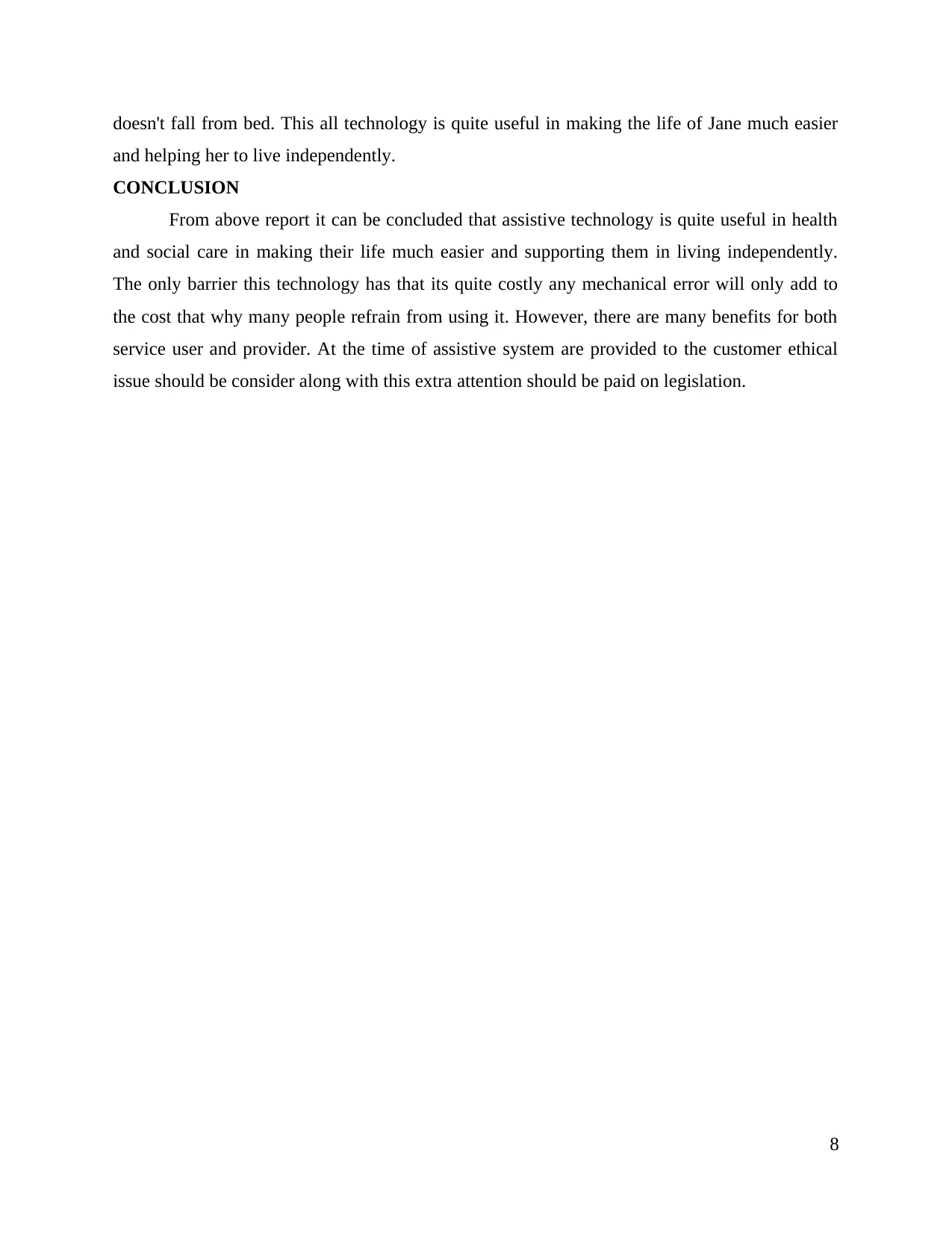
doesn't fall from bed. This all technology is quite useful in making the life of Jane much easier
and helping her to live independently.
CONCLUSION
From above report it can be concluded that assistive technology is quite useful in health
and social care in making their life much easier and supporting them in living independently.
The only barrier this technology has that its quite costly any mechanical error will only add to
the cost that why many people refrain from using it. However, there are many benefits for both
service user and provider. At the time of assistive system are provided to the customer ethical
issue should be consider along with this extra attention should be paid on legislation.
8
and helping her to live independently.
CONCLUSION
From above report it can be concluded that assistive technology is quite useful in health
and social care in making their life much easier and supporting them in living independently.
The only barrier this technology has that its quite costly any mechanical error will only add to
the cost that why many people refrain from using it. However, there are many benefits for both
service user and provider. At the time of assistive system are provided to the customer ethical
issue should be consider along with this extra attention should be paid on legislation.
8
Paraphrase This Document
Need a fresh take? Get an instant paraphrase of this document with our AI Paraphraser
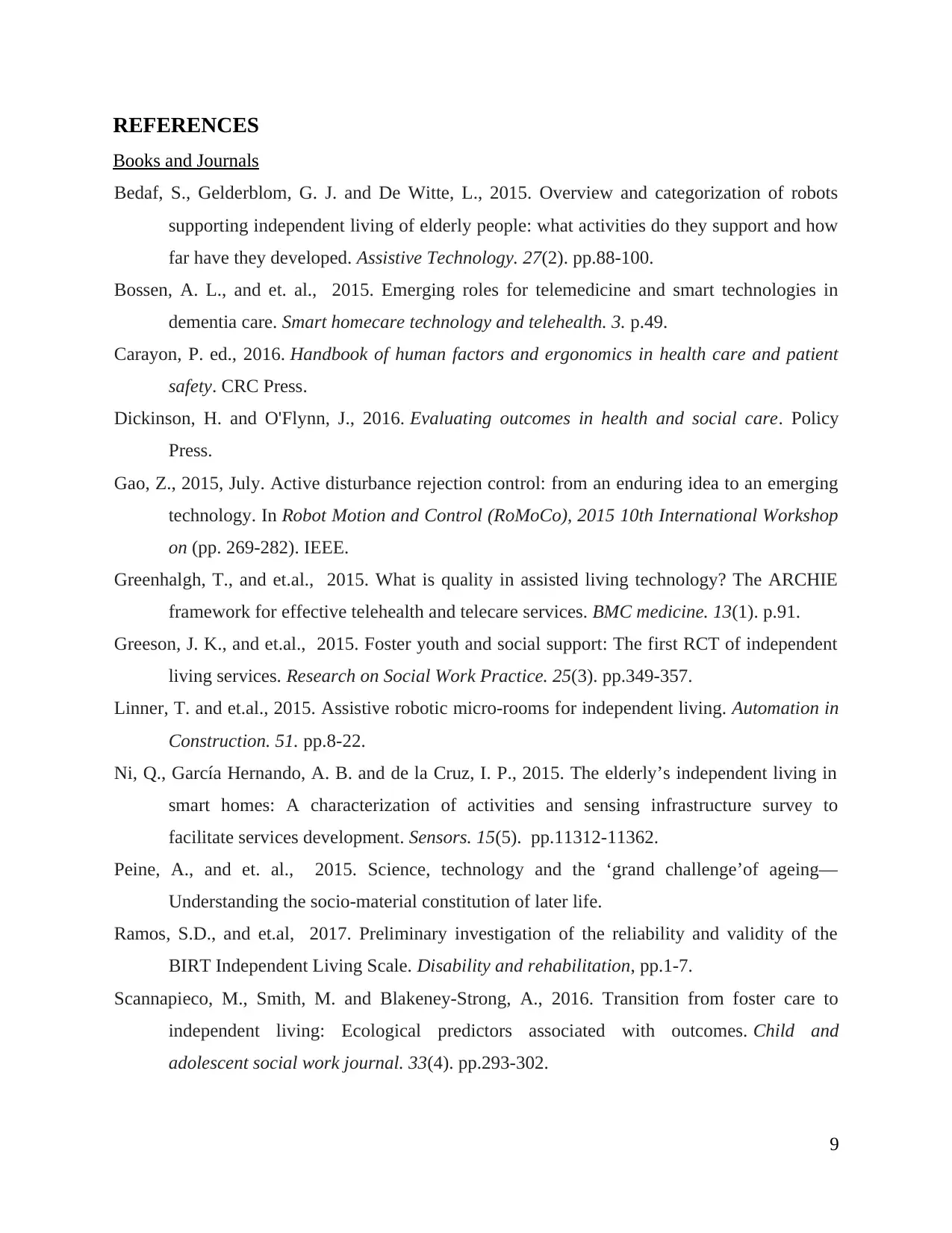
REFERENCES
Books and Journals
Bedaf, S., Gelderblom, G. J. and De Witte, L., 2015. Overview and categorization of robots
supporting independent living of elderly people: what activities do they support and how
far have they developed. Assistive Technology. 27(2). pp.88-100.
Bossen, A. L., and et. al., 2015. Emerging roles for telemedicine and smart technologies in
dementia care. Smart homecare technology and telehealth. 3. p.49.
Carayon, P. ed., 2016. Handbook of human factors and ergonomics in health care and patient
safety. CRC Press.
Dickinson, H. and O'Flynn, J., 2016. Evaluating outcomes in health and social care. Policy
Press.
Gao, Z., 2015, July. Active disturbance rejection control: from an enduring idea to an emerging
technology. In Robot Motion and Control (RoMoCo), 2015 10th International Workshop
on (pp. 269-282). IEEE.
Greenhalgh, T., and et.al., 2015. What is quality in assisted living technology? The ARCHIE
framework for effective telehealth and telecare services. BMC medicine. 13(1). p.91.
Greeson, J. K., and et.al., 2015. Foster youth and social support: The first RCT of independent
living services. Research on Social Work Practice. 25(3). pp.349-357.
Linner, T. and et.al., 2015. Assistive robotic micro-rooms for independent living. Automation in
Construction. 51. pp.8-22.
Ni, Q., García Hernando, A. B. and de la Cruz, I. P., 2015. The elderly’s independent living in
smart homes: A characterization of activities and sensing infrastructure survey to
facilitate services development. Sensors. 15(5). pp.11312-11362.
Peine, A., and et. al., 2015. Science, technology and the ‘grand challenge’of ageing—
Understanding the socio-material constitution of later life.
Ramos, S.D., and et.al, 2017. Preliminary investigation of the reliability and validity of the
BIRT Independent Living Scale. Disability and rehabilitation, pp.1-7.
Scannapieco, M., Smith, M. and Blakeney-Strong, A., 2016. Transition from foster care to
independent living: Ecological predictors associated with outcomes. Child and
adolescent social work journal. 33(4). pp.293-302.
9
Books and Journals
Bedaf, S., Gelderblom, G. J. and De Witte, L., 2015. Overview and categorization of robots
supporting independent living of elderly people: what activities do they support and how
far have they developed. Assistive Technology. 27(2). pp.88-100.
Bossen, A. L., and et. al., 2015. Emerging roles for telemedicine and smart technologies in
dementia care. Smart homecare technology and telehealth. 3. p.49.
Carayon, P. ed., 2016. Handbook of human factors and ergonomics in health care and patient
safety. CRC Press.
Dickinson, H. and O'Flynn, J., 2016. Evaluating outcomes in health and social care. Policy
Press.
Gao, Z., 2015, July. Active disturbance rejection control: from an enduring idea to an emerging
technology. In Robot Motion and Control (RoMoCo), 2015 10th International Workshop
on (pp. 269-282). IEEE.
Greenhalgh, T., and et.al., 2015. What is quality in assisted living technology? The ARCHIE
framework for effective telehealth and telecare services. BMC medicine. 13(1). p.91.
Greeson, J. K., and et.al., 2015. Foster youth and social support: The first RCT of independent
living services. Research on Social Work Practice. 25(3). pp.349-357.
Linner, T. and et.al., 2015. Assistive robotic micro-rooms for independent living. Automation in
Construction. 51. pp.8-22.
Ni, Q., García Hernando, A. B. and de la Cruz, I. P., 2015. The elderly’s independent living in
smart homes: A characterization of activities and sensing infrastructure survey to
facilitate services development. Sensors. 15(5). pp.11312-11362.
Peine, A., and et. al., 2015. Science, technology and the ‘grand challenge’of ageing—
Understanding the socio-material constitution of later life.
Ramos, S.D., and et.al, 2017. Preliminary investigation of the reliability and validity of the
BIRT Independent Living Scale. Disability and rehabilitation, pp.1-7.
Scannapieco, M., Smith, M. and Blakeney-Strong, A., 2016. Transition from foster care to
independent living: Ecological predictors associated with outcomes. Child and
adolescent social work journal. 33(4). pp.293-302.
9
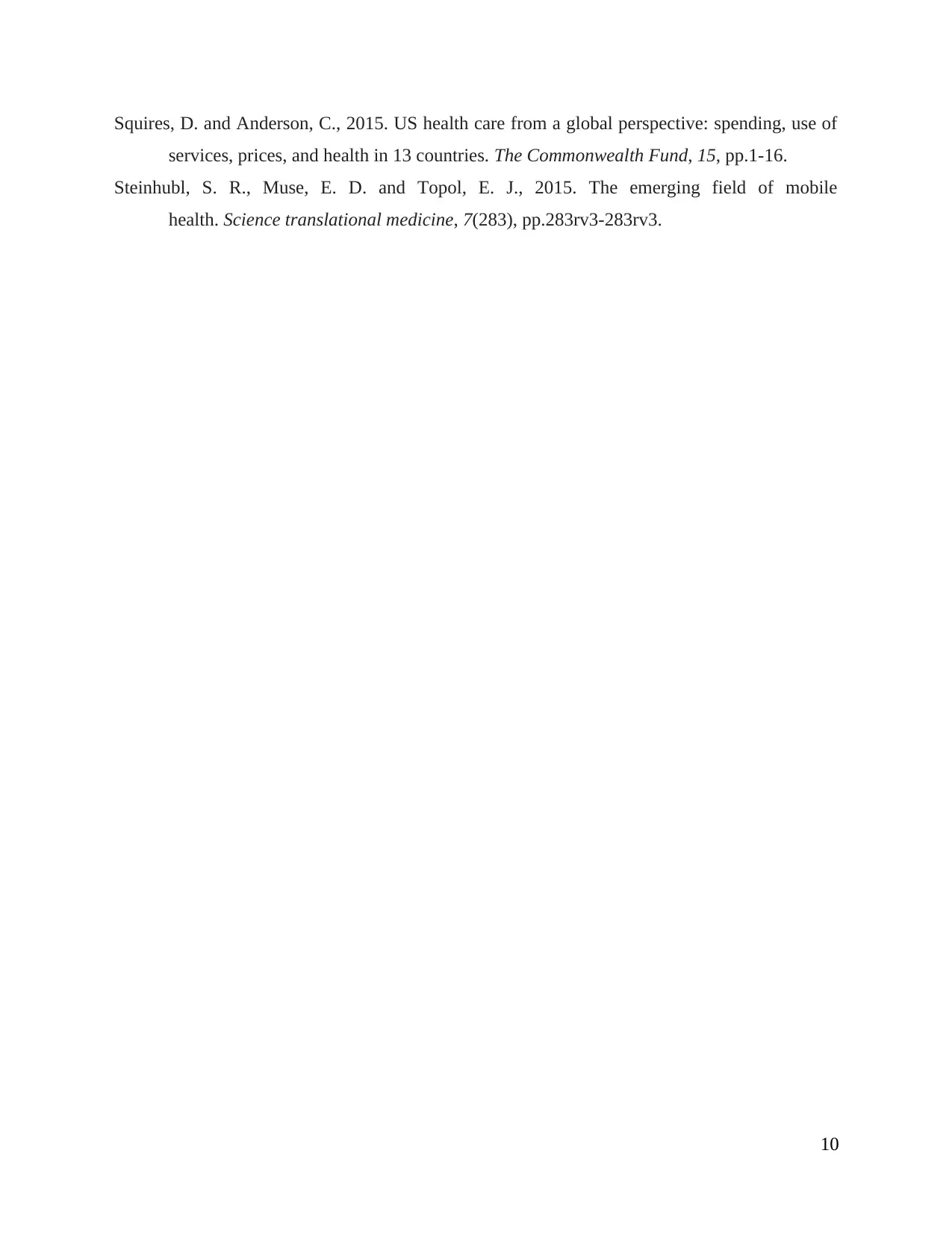
Squires, D. and Anderson, C., 2015. US health care from a global perspective: spending, use of
services, prices, and health in 13 countries. The Commonwealth Fund, 15, pp.1-16.
Steinhubl, S. R., Muse, E. D. and Topol, E. J., 2015. The emerging field of mobile
health. Science translational medicine, 7(283), pp.283rv3-283rv3.
10
services, prices, and health in 13 countries. The Commonwealth Fund, 15, pp.1-16.
Steinhubl, S. R., Muse, E. D. and Topol, E. J., 2015. The emerging field of mobile
health. Science translational medicine, 7(283), pp.283rv3-283rv3.
10
⊘ This is a preview!⊘
Do you want full access?
Subscribe today to unlock all pages.

Trusted by 1+ million students worldwide
1 out of 12
Related Documents
Your All-in-One AI-Powered Toolkit for Academic Success.
+13062052269
info@desklib.com
Available 24*7 on WhatsApp / Email
![[object Object]](/_next/static/media/star-bottom.7253800d.svg)
Unlock your academic potential
Copyright © 2020–2025 A2Z Services. All Rights Reserved. Developed and managed by ZUCOL.





